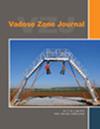Temporal covariance of spatial soil moisture variations: A mechanistic error modeling approach
IF 2.8
3区 地球科学
Q3 ENVIRONMENTAL SCIENCES
引用次数: 0
Abstract
When estimating field-scale average soil moisture from sensors measuring at fixed positions, spatial variability in soil moisture leads to “measurement errors” of the spatial mean, which may persist over time due to persistent soil moisture patterns resulting in autocorrelated measurement errors. The uncertainty of parameters that are derived from such measurements may be underestimated when they are assumed to be independent. Temporal autocorrelation models assume stationary random errors, but such error models are not necessarily applicable to soil moisture measurements. As an alternative, we propose a mechanistic error model that is based on the spatial variability of the water retention curve and assumes a uniform water potential. We tested whether spatial soil moisture variability and its temporal covariance could be predicted based on (1) mean soil moisture, (2) water retention variability, and (3) (co)variances of the van Genuchten parameters using a first-order expansion of the retention curve. The proposed models were tested in a numerical and a field experiment. For the field experiment, in situ sensor measurements and water retention curves were obtained in a field plot. Both experiments showed that water retention variability under a uniform water potential is a good predictor for spatial soil moisture variability, and that soil moisture errors are strongly correlated in time and neglecting them would be an incorrect assumption. The temporal error covariance could be predicted as a function of the mean moisture contents at two observation times. Further research is required to assess the impact of these temporal correlations on soil moisture predictions.空间土壤水分变化的时间协方差:机理误差建模方法
当利用在固定位置测量的传感器估算田间尺度的平均土壤湿度时,土壤湿度的空间变异性会导致空间平均值的 "测量误差",这种误差可能会随着时间的推移而持续存在,这是因为土壤湿度模式的持续性导致了自相关的测量误差。如果假定这些测量值是独立的,那么从这些测量值推导出的参数的不确定性可能会被低估。时间自相关模型假定存在静态随机误差,但这种误差模型并不一定适用于土壤水分测量。作为替代方案,我们提出了一种基于保水曲线空间变异性的机理误差模型,并假定水势是均匀的。我们测试了是否可以根据 (1) 平均土壤水分、(2) 水分保持率变异性和 (3) 使用保持率曲线一阶展开的范-格努赫腾参数(共)方差来预测土壤水分的空间变异性及其时间协方差。在数值实验和实地实验中对所提出的模型进行了测试。在现场实验中,在一块田地上进行了现场传感器测量并获得了保水曲线。这两项实验都表明,均匀水势下的保水性变化可以很好地预测土壤水分的空间变化,而且土壤水分误差在时间上具有很强的相关性,忽略这些误差是不正确的假设。时间误差协方差可作为两个观测时间的平均含水量的函数来预测。需要进一步研究评估这些时间相关性对土壤水分预测的影响。
本文章由计算机程序翻译,如有差异,请以英文原文为准。
求助全文
约1分钟内获得全文
求助全文
来源期刊

Vadose Zone Journal
环境科学-环境科学
CiteScore
5.60
自引率
7.10%
发文量
61
审稿时长
3.8 months
期刊介绍:
Vadose Zone Journal is a unique publication outlet for interdisciplinary research and assessment of the vadose zone, the portion of the Critical Zone that comprises the Earth’s critical living surface down to groundwater. It is a peer-reviewed, international journal publishing reviews, original research, and special sections across a wide range of disciplines. Vadose Zone Journal reports fundamental and applied research from disciplinary and multidisciplinary investigations, including assessment and policy analyses, of the mostly unsaturated zone between the soil surface and the groundwater table. The goal is to disseminate information to facilitate science-based decision-making and sustainable management of the vadose zone. Examples of topic areas suitable for VZJ are variably saturated fluid flow, heat and solute transport in granular and fractured media, flow processes in the capillary fringe at or near the water table, water table management, regional and global climate change impacts on the vadose zone, carbon sequestration, design and performance of waste disposal facilities, long-term stewardship of contaminated sites in the vadose zone, biogeochemical transformation processes, microbial processes in shallow and deep formations, bioremediation, and the fate and transport of radionuclides, inorganic and organic chemicals, colloids, viruses, and microorganisms. Articles in VZJ also address yet-to-be-resolved issues, such as how to quantify heterogeneity of subsurface processes and properties, and how to couple physical, chemical, and biological processes across a range of spatial scales from the molecular to the global.
 求助内容:
求助内容: 应助结果提醒方式:
应助结果提醒方式:


